Daisy The April Birth Flower
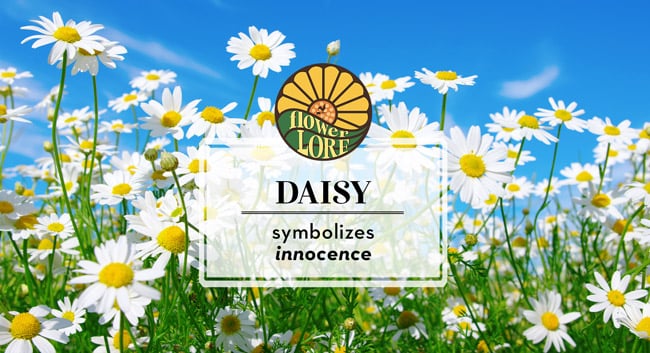
With their sunny booms, quick growth, and innocent childhood associations, daisies are the ultimate spring flower and a perfect choice as the April birth flower. But why are these sweet blooms associated with April and what does folklore say about daisy flower meaning? Here’s everything you need to know about daisies to celebrate spring. Plus, some fun facts about the April birth month alternative flower, sweet pea.
About Daisies
Daisies are part of the flower family Asteraceae, which includes roughly 24,000 species of not only daisies but also asters, blanketflowers, coneflowers, black eyed susans, sunflowers, and other related blooms—nearly 10% of the flower species in the world in total.
When discussing the daisy as the birth flower for April, the common daisy (Bellis perennis) is the most frequent choice. These sweet, innocent blooms are also known as wild daisies, lawn daisies, garden daisies, meadow daisies, and English daisies. Other alternative names include bruisewort, woundwort, and bone flower.
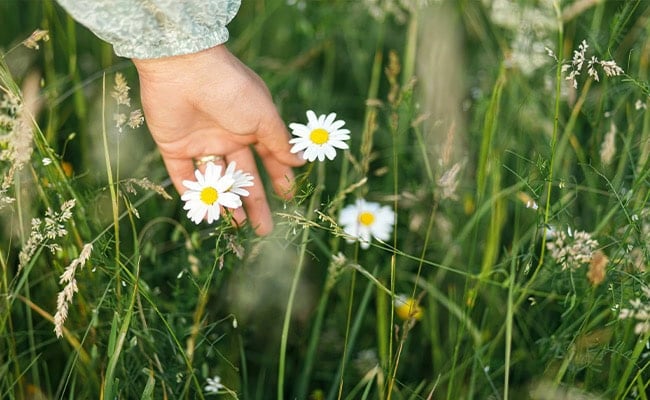
The etymology of the flower’s name has several explanations. Daisy is thought to come from the Old English dægesege or “day’s eye” which indicates the flower’s unique behavior of closing fully at night but opening with the sun. In Medieval Latin, this is solis oculus, “Sun’s eye.” These flowers also exhibit heliotropism, changing their orientation throughout the day to follow the sun—another reason to call them “day’s eye” flowers.
The flower’s Latin name Bellis perennis comes from the original Latin “bellus” meaning beautiful and “perennis” for everlasting, highlighting not only prettiness of the flowers but also their lengthy bloom time. Depending on the exact flower variety and the conditions where it grows, daisies can bloom for mid-spring as far as into late summer or even early fall.
The common daisy originated in the fields and meadows of northern, western, and central Europe and western Asia. Today, these herbaceous perennials are found naturalized in many other parts of the world, including both North and South America as well as Australia.
It must be noted that while Bellis perennis is the official birth month flower for April, many other types of daisies—shasta daisies and gerbera daisies, for example—also make popular and thoughtful gifts with the same symbolic association.
Daisy Symbolism
Daisies are considered to be composite flowers (two blooms in one flower). The white petals are one bloom, while the yellow center is another. This gives deeper symbolism to one of the flower’s meanings—true love—as it shows to parts coming together for a harmonious whole. Devotion and affection are similar meanings often associated with these flowers.
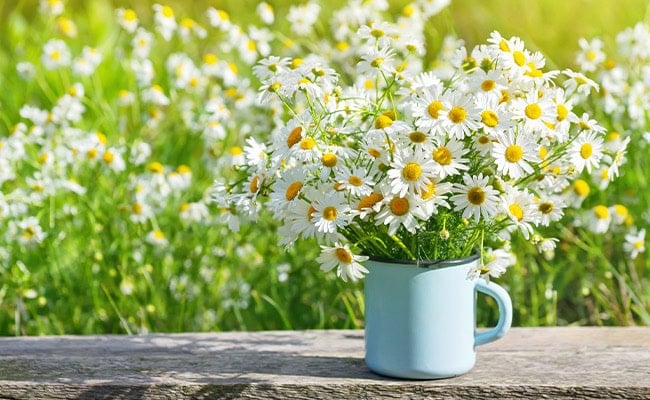
The white part of daisies also means purity and innocence. With these qualities, daisies are often associated with the Virgin Mary as well as the new beginnings of motherhood and childbirth, making daisy bouquets the ideal gift for a new mother.
The rejuvenation of daisies and the fact that they are a prolific early spring bloom also connects to fertility, new beginnings, and rebirth, qualities often associated with April as nature returns to rich, vibrant life after the winter.
Daisy Flower Meaning Around The World
Different cultures have different folklore about daisies. In Celtic legends, for example, the gods grow daisies over the gravesites of children and infants to bring cheer to parents, imparting both a hopeful as well as a sorrowful meaning to the blooms. Similarly in Chinese culture, daisies are often associated with death and sympathy. Even the modern adage “pushing up the daisies” connects these flowers to the grave.
Norse mythology associates daisies with Freya, the goddess of love, beauty, and fertility, claiming the flowers are sacred to her. Meanwhile in Roman mythology, the nymph Belides—considered in part the origin of the name “bellus”—is said to have transformed into a daisy in order to escape the unwanted attentions of the god of gardens and seasons, Vertumnus. This could be connected to another meaning for daisies—the idea of keeping secrets—as the daisy successfully hid Belides.
In more modern floriography (language of flowers) daisies represent being independent and free-thinking, which are nods to the flowers’ easy naturalization and wild profusion. (See “Growing Daisies” section below.)
Any questions? Contact [email protected]
Cooking With Daisies
Because daisies are so widespread and easily found, they have a long history of use as food and folk medicine. The young leaves and petals of daisies have a fresh, light flavor great for salads or sandwiches, and the blooms can be sugared or left plain as simple decorations for cakes, cupcakes, and cookies.
Daisies can also be used in soups or sautéed as a natural side dish, and they may be infused in honey or mixed with butter for unique flavoring. Older, more mature daisies tend to have more of a bitter, astringent taste and are less desirable for food uses.
Daisies In Folk Medicine
Daisies have been used to treat wounds and for other medicinal treatments since ancient Egyptian and Roman eras. They are known to have some mild antibacterial properties that help promote healing, and are also anti-inflammatory (often used for arthritis, rheumatism, or headaches). Ointments infused with daisies are popular for treating skin issues such as wrinkles, sunspots, eczema, bruises, and other skin damage.
While there are no modern treatments that focus on daisies as a cure-all, these flowers are often cited as helpful homeopathic remedies for conditions like coughing, colds, bronchitis, ulcers, digestive trouble, bloating, constipation, diarrhea, and even eye problems.
Note: Farmers’ Almanac does not give medical advice. The information provided here is intended for educational purposes only. Please work with a professional If you do choose to forage botanicals in nature.
Daisy as a Name
One fun association with daisies, along with several other birth month flowers, is the use of “Daisy” as a feminine name. In fact, Daisy has been one of the top 200 feminine names in the United States since 1990, when previously the name was ranked as low as in the 600s.
Daisy is also a fun nickname for Margaret, taken from the French “marguerite” which is another name for the oxeye daisy (Leucanthemum vulgare).
Today, famous Daisys include Daisy Duke of The Dukes of Hazzard fame along with Walt Disney’s quack-tastic girlfriend of Donald, Daisy Duck and characters in Downton Abbey and Grey’s Anatomy. Famous Daisys are found in a variety of literary settings, including Daisy Buchanan in F. Scott Fitzgerald’s The Great Gatsby.
Daisy is also the name of a variety of cities in Arkansas, Georgia, Kentucky, Maryland, Virginia, and other states, as well as in Australia and Canada.
Games With Daisies
Because daisies are so prolific, they’ve been used by creative children for generations as features in games. The “he-loves-me, he-loves-me-not” use of a daisy, plucking petals to see if a romantic feeling might be returned, is a classic connection to the innocence and true love these flowers represent.
Daisies are also the perfect flowers to create the aptly named “daisy chains” – a long strand of interlocked blooms. The stems can be carefully slit with a fingernail, with the stem of the next flower threaded through each hole to create a longer and longer strand. These strands can be connected to create a wreath, necklace, bracelet, or other accessory that children love to show off in the spring and summer.
Related product: April Birthstone – Malachite Necklace
Growing Daisy Plants
With so much wonderful symbolism to enjoy, daisies are ideal to add to a family garden as the April birth flower or to represent any special moment in the month, or just as a lovely and sweetly innocent addition to the landscape. Their long bloom time, from mid-spring to late summer or early fall depending on the exact variety and growing conditions, also makes daisies a popular addition to many gardens, and there is evidence that daisies have been cultivated since as early as 2200 BC.
Daisy plants can be grown in containers, window boxes, or directly in the ground with minimal maintenance and care—the perfect plants for beginners. It should be noted, however, that they could overtake an area if left untended, and in some areas may even be considered weeds or invasive. Many gardeners, on the other hand, love that naturalized look and find daisies to be a pleasant ground cover or a key feature of a cottage garden.
Daisies are hardy in gardening zones 4-9, where they are lovely choices as perennials and can easily be grown from seeds or seedlings. They prefer well-drained soil and can thrive in a variety of soil types, but good air circulation is necessary to minimize the risk of powdery mildew and other funguses that can infect the plants. Ideally, plant daisies 24-30 inches apart, and consider thinning them regularly to prevent overcrowding and improve overall plant health.
While there are smaller daisy varieties that only grow to eight inches tall, taller varieties may need staking to ensure they don’t tip or weep in the garden. Protecting these flowers from strong winds can also help them remain vibrantly upright.
For the best, most beautiful blooms, daisies should be planted in full sun or partial shade and offered a general fertilizer to nourish their growth. Pay particular attention to the phosphorus content of the fertilizer, a key component in ensuring flower growth and exceptional blooms, especially for more colorful daisy varieties.
These flowers will begin to wilt when they are thirsty, providing an easy clue to their watering needs, but they recover quickly once given an appropriate drink. If Mother Nature does not oblige with adequate rain, providing daisies one to two inches of water per week, ideally through a soaker hose or drip system at the base of the plant, is sufficient to keep them well-watered.
While naturalized daisies can be a delight all across the lawn, pinching back daisy plants can help them keep a bushier, more contained shape in flowerbeds or containers. Deadheading spent blooms will also encourage more blooming and offer longer enjoyment of these cheery flowers.
Gardeners should note that both deer and rabbits enjoy a tasty snack of daisies, so it may be necessary to take other steps to discourage these visitors in order to preserve beautiful daisies in landscaping beds or dedicated containers.
The Alternate April Birth Flower: Sweet Pea
While daisies are acknowledged as the most popular April birth month flower, the sweet pea (Lathyrus odoratus) is an alternative option also associated with April. These flowers, which are related to legumes and beans and are native to Italy and the Mediterranean region, symbolize thanks and good wishes, as well as blissful pleasure, gratitude, sincerity, and friendship. A traditional gift for brides, sweet pea’s light fragrance makes them an uplifting and popular bloom. Unlike daisies, however, they are toxic and are not as useful for food or medicinal applications.
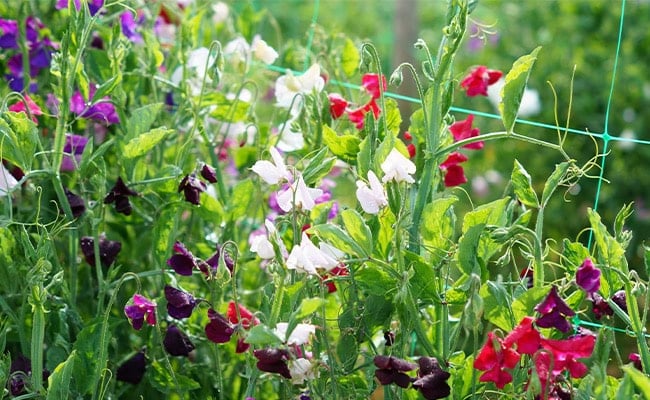
Whether daisies or sweet peas, choosing a symbolic April birth flower to plant in a family garden, offer as a thoughtful gift, or use in bouquets or arrangements can be a wonderful gesture with deeper meaning than many people may realize. By better understanding the lore and legends behind these familiar flowers, we can all better appreciate just how rich and lovely daisies and other birth flowers can be.
Join The Discussion
Which flower do you prefer: daisies or sweet peas?
Did anything surprise you about the daisy flower’s meaning?
Share your tips and tricks for the most beautiful daisies and sweet peas in the comments below!

Melissa Mayntz
Melissa Mayntz is a writer who specializes in birds and birding, though her work spans a wide range—from folklore to healthy living. Her first book, Migration: Exploring the Remarkable Journeys of Birds was published in 2020. Mayntz also writes for National Wildlife Magazine and The Spruce. Find her at MelissaMayntz.com.


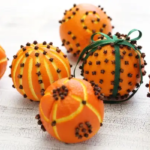



I am in my 60’s. All my life I have known the April birth flower to be sweet peas. Never until this article, have I heard of daisies s a birth flower for April.
This is weird.